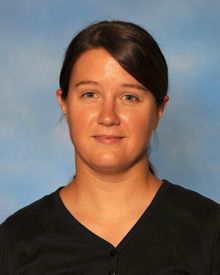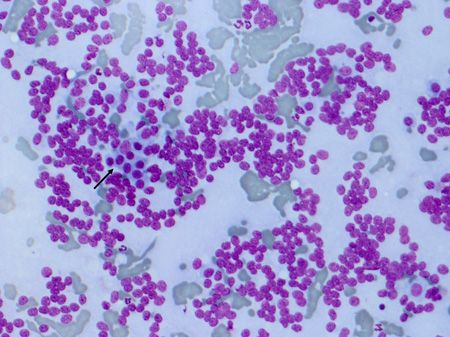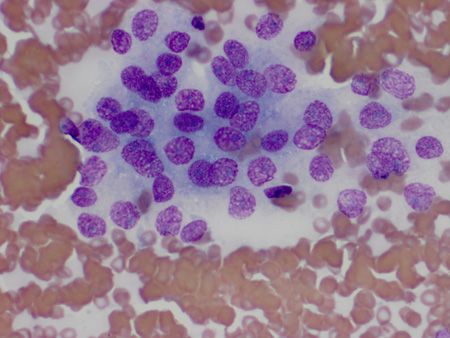Insulinoma in a senior pit bull: Clinical pathology perspective
Dr. Lisa Viesselmann provides the clinical pathology perspective on this challenging veterinary oncology case.

Dr. Lisa ViesselmannCytologic samples of pancreatic masses suspected to be insulinomas are obtained most commonly via percutaneous ultrasound-guided or intraoperative fine-needle aspiration (FNA). Impression smears of surgical biopsy samples can also be used. Recently, an endoscopic ultrasound-guided FNA technique has also been introduced.1 Aspiration of the pancreas has been shown to result in minimal tissue trauma with a low incidence of adverse effects and frequently yields samples of adequate diagnostic cellularity.2 Ultrasound-guided FNA does not appear to cause increases in pancreatic lipase or trypsin-like immunoreactivity or to cause clinical signs of pancreatitis.3
Cytologic samples of insulinomas are often highly cellular and appear similar to many other endocrine and neuroendocrine neoplasms. Insulinoma cells are fragile, so cytologic samples are characterized by large numbers of free, round nuclei in a sea of pale basophilic to amphophilic cytoplasm (“naked nuclei” morphology) (Figure 3).

Figure 3. A low-power view of a pancreatic fine-needle aspirate from a dog (not the dog in this case) with an insulinoma (Wright's stain; 200x). The sample is highly cellular, and large numbers of free nuclei appear in a sea of pale basophilic cytoplasm. A small cluster of intact cells is present (arrow), but the remainder of the cells have been broken. This "naked nuclei" morphology is commonly seen with neuroendocrine tumors. The nuclei have a uniform appearance, with minimal anisokaryosis. Occasionally, cells will be present in loose clusters, but their cytoplasmic borders are usually indistinct. Intact cells are equivalent in size to or larger than the diameter of a neutrophil, with centrally located, round to oval nuclei. The chromatin is usually finely to coarsely stippled, and a single distinct nucleolus is often visible (Figure 4).

Figure 4. A fine-needle aspirate of a pancreatic insulinoma in a dog (not the dog in this case) (Wright's stain; 500x). The cells are loosely packeted, but cytoplasmic borders are indistinct. The nuclei contain finely to coarsely stippled chromatin with one to two prominent nucleoli.Clear, discrete, punctate cytoplasmic vacuoles are variably present. Mild to moderate anisocytosis and anisokaryosis and occasional binucleation, nuclear molding, and mitotic figures may be seen. However, the cells often lack striking features of malignancy, even in cases of carcinoma.4 Therefore, cytologic appearance is not predictive of biologic behavior in these tumors. As stated previously, insulinomas are frequently malignant, and metastatic lesions have a similar cytologic appearance to the original tumor.
Insulinomas are typically interpreted cytologically as neuroendocrine tumors. Other pancreatic neuroendocrine tumors include glucagonomas, gastrinomas, pancreatic polypeptide-secreting tumors and somatostatinomas, and these are generally indistinguishable from insulinomas cytologically.5 Carcinoids, chemodectomas, apocrine gland anal sac adenocarcinomas and thyroid tumors also have a neuroendocrine appearance. Therefore, cytologic findings from a suspected insulinoma must be interpreted in light of the patient's history, clinical signs, imaging results and other laboratory findings.
References
1. Kook PH, Baloi P, Ruetten M, et al. Feasibility and safety of endoscopic ultrasound-guided fine needle aspiration of the pancreas in dogs. J Vet Intern Med 2012;26:513-517.
2. Cordner AP, Sharkey LC, Armstrong PJ, et al. Cytologic findings and diagnostic yield in 92 dogs undergoing fine-needle aspiration of the pancreas. J Vet Diagn Invest 2015;27:236-240.
3. Cordner AP, Armstrong PJ, Newman SJ, et al. Effect of pancreatic tissue sampling on serum pancreatic enzyme levels in clinically healthy dogs. J Vet Diagn Invest 2010;22:702-707.
4. Valenciano AC, Cowell RL. The pancreas. In: Cowell and Tyler's diagnostic cytology and hematology of the dog and cat. 4th ed. St. Louis: Elsevier, 2014.
5. Raskin RE, Meyer DJ. Endocrine/neuroendocrine system. In: Canine and feline cytology; a color atlas and interpretation guide. 3rd ed. St. Louis: Elsevier, 2016.